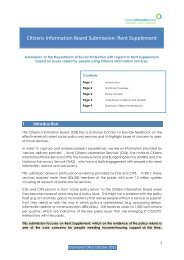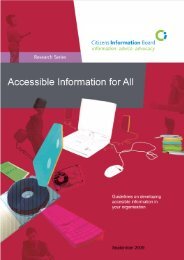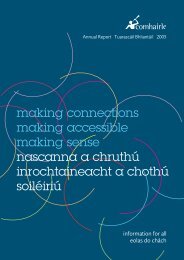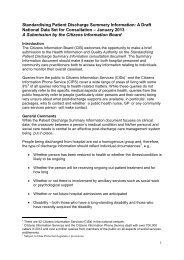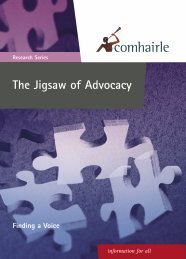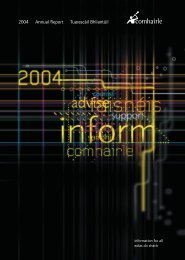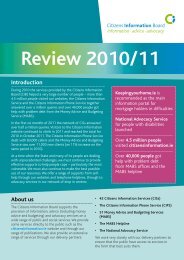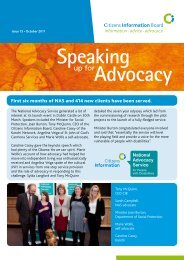Review of Sign Language Interpretation Services and Service ...
Review of Sign Language Interpretation Services and Service ...
Review of Sign Language Interpretation Services and Service ...
- No tags were found...
Create successful ePaper yourself
Turn your PDF publications into a flip-book with our unique Google optimized e-Paper software.
The use <strong>of</strong> videophones <strong>and</strong> webcams for remote interpreting <strong>and</strong>/orcommunication between sign language users has been increasing over the pastnumber <strong>of</strong> years. The impetus for these developments has come from two sides.On the one h<strong>and</strong> there are hearing users <strong>of</strong> interpreting services, agenciesproviding interpreters <strong>and</strong> governments promoting the use <strong>of</strong> these technologies.On the other, there are Deaf people themselves, <strong>and</strong> their wish to take advantage<strong>of</strong> the opportunities presented by new technology.However, one should not overestimate the responsiveness <strong>of</strong> Deaf people tothese new opportunities. Allsop et al (2005), were commissioned by the ScottishExecutive to investigate the extent <strong>of</strong> Deaf people's access to public services inScotl<strong>and</strong>. They concluded that although videophones have been available invarious locations around the country for six years now, video communications“have made little impact on the Deaf Community”. Of those questioned, over 92%had rarely or never used a webcam <strong>and</strong> over 98% had never used a videophone.However, there is no analysis available on why this figure is so high.One reason may be that videophones are not currently seen or available asmainstream equipment, so there are barriers to be overcome in order to train theuser so that it becomes the norm (in the way that so many people now use theubiquitous mobile phone <strong>and</strong> SMS each day).However, more research needs to be carried out in this area to ensure that theDeaf community will make use <strong>of</strong> any new technologies through whichinterpreting services are provided. Research is beginning to emerge, debatinghow these technologies will affect sign language interpreters working conditions,e.g. Sharon Lee, 'How will we define our future as online interpreters' paper to theSupporting Deaf People, online conference, 2001.Video-relay/videophonesAn example <strong>of</strong> a video relay system can be found in Engl<strong>and</strong> where the RNIDplans to develop their Typetalk relay system (whereby conventionally an operatorrelays a message between a Deaf person using a text phone <strong>and</strong> a hearing personusing a conventional phone). The RNID plans to use an interpreter in place <strong>of</strong> theoperator <strong>and</strong> a videophone instead <strong>of</strong> a textphone. This will enable a Deaf personusing BSL to communicate with a hearing person using a telephone, via theinterpreter who would be using a videophone.Another example <strong>of</strong> a video relay interpreting system in Engl<strong>and</strong> is the serviceprovided by <strong>Sign</strong>ificant UK Ltd., a private company operating out <strong>of</strong> London.The company has a pool <strong>of</strong> freelance interpreters working on a rota basis in avideo relay call centre. They currently have eight work stations, but are planningto have a virtual call centre, which will exp<strong>and</strong> to incorporate interpreters workingfrom home.The British government has been very supportive <strong>of</strong> the '<strong>Sign</strong>ificant' initiative <strong>and</strong>has provided funding to cover the first year <strong>of</strong> the service, with a total investmentin the region <strong>of</strong> £500,000 (approximately €700,000). <strong>Sign</strong>ificant has beencontracted to provide remote interpreting services to local authorities in Engl<strong>and</strong>.It is the intention that videophones will be installed in each <strong>of</strong> the local authoritiesin time, to facilitate Deaf people accessing public services.page 96 • <strong>Review</strong> <strong>of</strong> <strong>Sign</strong> <strong>Language</strong> <strong>Interpretation</strong> <strong><strong>Service</strong>s</strong> <strong>and</strong> <strong>Service</strong> Requirements in Irel<strong>and</strong>



